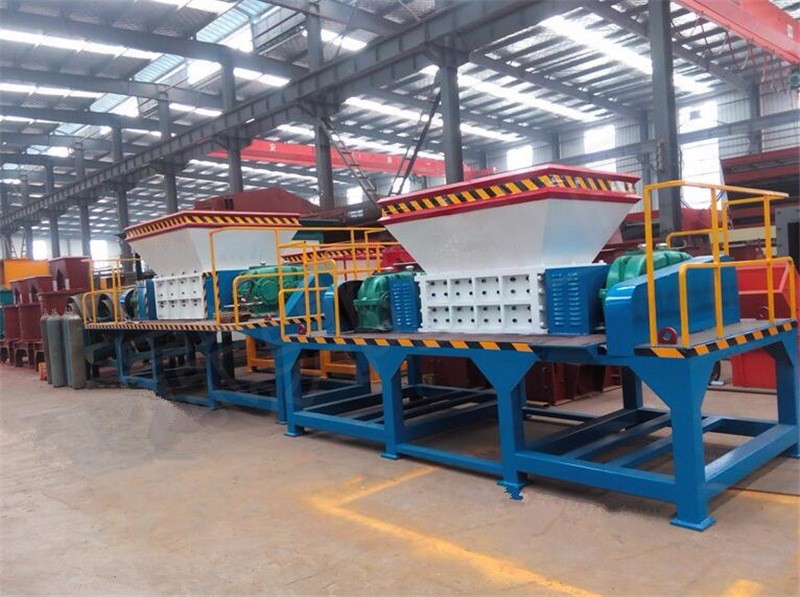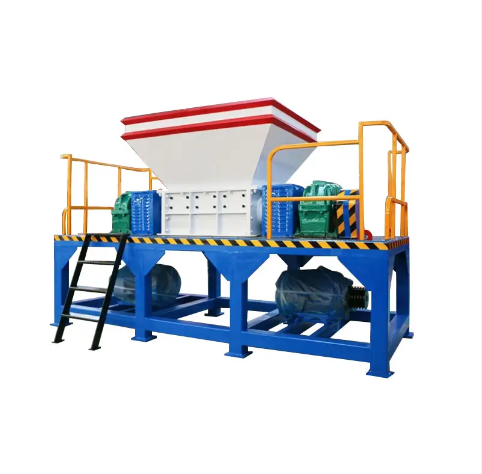
Crush to Create: The Ultimate Eco-Friendly Plastic Shredder Revolution
-
Production Capacity:
-
Applicable Industries:
-
Power:
-
Core Components:
-
Place of Origin:
Henan, China
- Product Details
- Characteristics
- Working Principle and Application
- Parameters
1. Plastic shredders are often of moderate size, easy to move flexibly in different work sites, and easy to operate and safe.
2. Efficient crushing system: Using a high-speed rotating blade shaft and specially designed cutting tools, it can quickly and effectively shred plastic materials. Some high-end models, such as dual axis plastic shredders, are equipped with dual axis independent drives to improve crushing efficiency and reduce jamming.
3. Environmental protection and energy conservation: The built-in filter device can separate materials and liquids, realizing the recycling and reuse of resources, such as recovering residual gasoline when crushing gasoline bottles. At the same time, the equipment is equipped with high-efficiency and energy-saving motors to ensure low operating costs and environmental protection.
4. Multifunctionality: Suitable for various plastic products and materials of different sizes, including but not limited to logs, pipes, clothing, rubber, and even tree branches and leaves, demonstrating a wide range of application adaptability.
5. Safe operation and maintenance: Emphasis is placed on following strict operating procedures, including checking the direction of impeller rotation, controlling feed particle size, uniform and continuous feeding, etc., to ensure stable operation of the equipment and extend its service life.
-
01Diversified structural design: Plastic crushers come in various designs such as single axis and double axis, with different numbers of axes and tool layouts to accommodate different types of plastic materials and crushing needs. For example, a dual axis plastic shredder is suitable for processing large, hard, or tough plastics, while a single axis design may be more suitable for soft materials such as films and threads.
-
02High efficiency motor and transmission system: equipped with a high-efficiency electric motor, usually with a power range of 3.5 kW to 150 kW, paired with a reducer to control the speed of the cutter roller (usually between 150 and 500 rpm), ensuring that the crushing process is both powerful and energy-saving.
-
03Precise tool configuration: Blades made of alloy steel or special heat-treated materials (such as DC53 steel) have a long service life. The V-shaped layout design of the moving blade, adjustable clearance between the moving blade and the fixed blade, and adjustable angle of the moving blade design enhance crushing efficiency and flexibility, while also facilitating tool maintenance and replacement.
-
04Accurate tool configuration: Blades made of alloy steel or special heat-treated materials (such as DC53 steel) have a long service life. The V-shaped layout design of the moving blade, the adjustable gap between the moving blade and the fixed blade, and the adjustable angle of the moving blade design improve crushing efficiency and flexibility, while also facilitating tool maintenance and replacement.
The working principle of a plastic shredder is mainly to tear large plastic materials into small pieces or fragments through mechanical force, in order to facilitate subsequent processing or recycling. The following is a detailed explanation of the working principle and application of the plastic shredder:
Working principle
1. Feeding system: Firstly, the plastic materials that need to be processed are sent to the crushing chamber of the shredder through manual or automatic conveyor belts.
2. Crushing chamber structure: The crushing chamber is equipped with high-speed rotating double or multiple shafts, which are fitted with sharp blades. These blades may adopt a combination of fixed and movable blades, or a specific shape of tool arrangement, such as a four corner rotating tool, depending on the design.
3. Tearing process: After the motor is started, the blade shaft begins to rotate at high speed. Through the interaction between the blades, the plastic material entering the crushing chamber is torn, squeezed, and sheared, gradually shredding it into smaller pieces. The dual axis design can also produce a certain squeezing effect, which helps to handle materials with higher hardness and reduces the risk of entanglement.
4. Filtration and Separation: Some advanced plastic shredders are also equipped with a filter screen device inside, which can separate liquids such as residual gasoline, water, etc. from the material during the shredding process, achieving effective resource recovery.
5. Discharge control: The crushed plastic fragments are controlled in particle size through a sieve or grid. The fragments that meet the requirements are discharged from the bottom, and those that do not meet the requirements continue to be crushed in the crushing chamber until they reach the set particle size requirements.
Application
1. Plastic recycling: widely used in the pre-treatment of plastic products such as mineral water bottles, PET bottles, plastic buckets, plastic bags, plastic pipes, and waste toys, preparing for subsequent cleaning, melting, and granulation.
2. Resource recycling: The shredded plastic fragments can be further processed into recycled plastic pellets, which can be used to produce new plastic products such as packaging materials, building supplies, household items, etc., achieving the recycling of plastic resources.
3. Environmental treatment: In the waste disposal and environmental protection industry, plastic shredders help reduce the volume of plastic waste, facilitate transportation and storage, and reduce the environmental pressure caused by landfill and incineration.
4. Industrial waste treatment: In addition to daily plastic, it also plays a role in the treatment of industrial waste such as electronic waste, automotive waste parts, medical waste, etc. By shredding and pre-treatment, the reuse rate of waste can be improved.
In summary, plastic shredders are an indispensable part of the plastic recycling industry chain, promoting the recycling and sustainable development of plastic resources through efficient and environmentally friendly methods.
| Model | 600 | 800 | 1000 | 1200 | 1400 | 1600 | 1800 |
| Motor(kw) | 11*2 | 18.5*2 | 35*2 | 45*2 | 55*2 | 75*2 | 110*2 |
Reducer | P6-P7 | P7-P8 | P8-P10 | P10-P12 | P11-P13 | P12-P16 | P14-P16 |
| Siemens or other motors, planetary reducers or other reducers can be customized according to customer requirements | |||||||
| Rotation Speed | 8-20rmp | 8-20rmp | 8-15rmp | 8-15rmp | 8-15rmp | 8-12rmp | 8-12rmp |
| Blades Diameter | 220-320 | 260-320 | 260-400 | 400-500 | 400-500 | 500 | 500 |
| Blades material | The material of the blades (55sicr, 5crsi, 9crsi, skd11, m6v, h13) can be customizedaccording to the customer's actual usage | ||||||
| Feeding Size | 1200*900mm | 1400*1000mm | 1600*1200mm | 1800*1300mm | 2000*1300mm | 2200*1700mm | 2400*2000mm |
| The size and appearance of the feeding hopper can be customized according to thecustomer's feeding situation | |||||||
| Weight(kg) | 1800 | 2500 | 3700 | 5500 | 7500 | 9500 | 13000 |
-
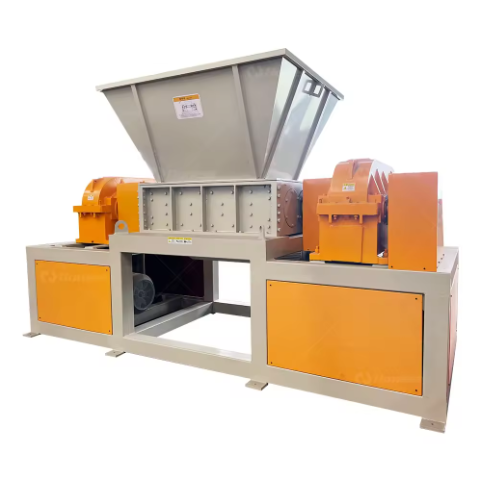 Twin-shaft shredders: ideal for efficient processing of waste and recycling materialsA double-shaft shredder is a mechanical device used to process waste and recycle materials. Its main feature is that it has two rotating shafts with serrated bl...Get Quote
Twin-shaft shredders: ideal for efficient processing of waste and recycling materialsA double-shaft shredder is a mechanical device used to process waste and recycle materials. Its main feature is that it has two rotating shafts with serrated bl...Get Quote -
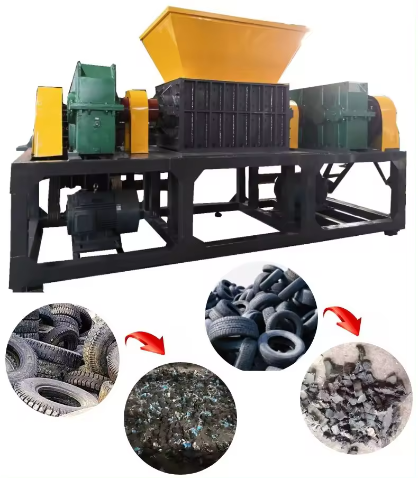 Scrap rubber product shredderThe shredder of waste rubber products not only helps to reduce environmental pollution, but also improves the reuse rate of waste rubber, which is one of the im...Get Quote
Scrap rubber product shredderThe shredder of waste rubber products not only helps to reduce environmental pollution, but also improves the reuse rate of waste rubber, which is one of the im...Get Quote -
 Crush to Create: The Ultimate Eco-Friendly Plastic Shredder RevolutionThe working principle of a plastic shredder is mainly to tear large plastic materials into small pieces or fragments through mechanical force, in order to facil...Get Quote
Crush to Create: The Ultimate Eco-Friendly Plastic Shredder RevolutionThe working principle of a plastic shredder is mainly to tear large plastic materials into small pieces or fragments through mechanical force, in order to facil...Get Quote -
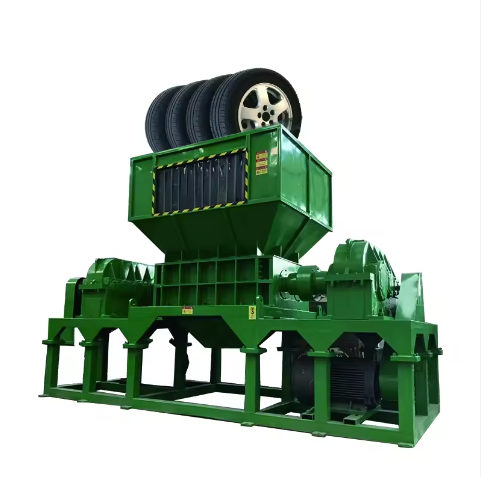 Tire double shaft shredderOperation:Feeding: Whole or pre-cut tires are fed into the shredder through an inlet hopper.Shredding: As the tires enter the shredding chamber, the rotating cu...Get Quote
Tire double shaft shredderOperation:Feeding: Whole or pre-cut tires are fed into the shredder through an inlet hopper.Shredding: As the tires enter the shredding chamber, the rotating cu...Get Quote



